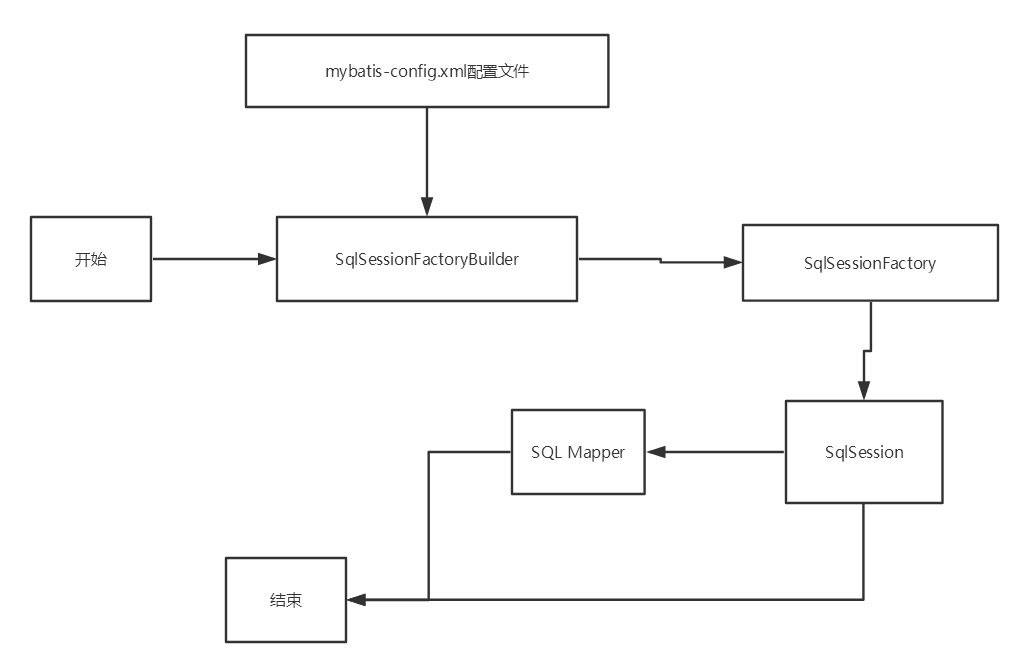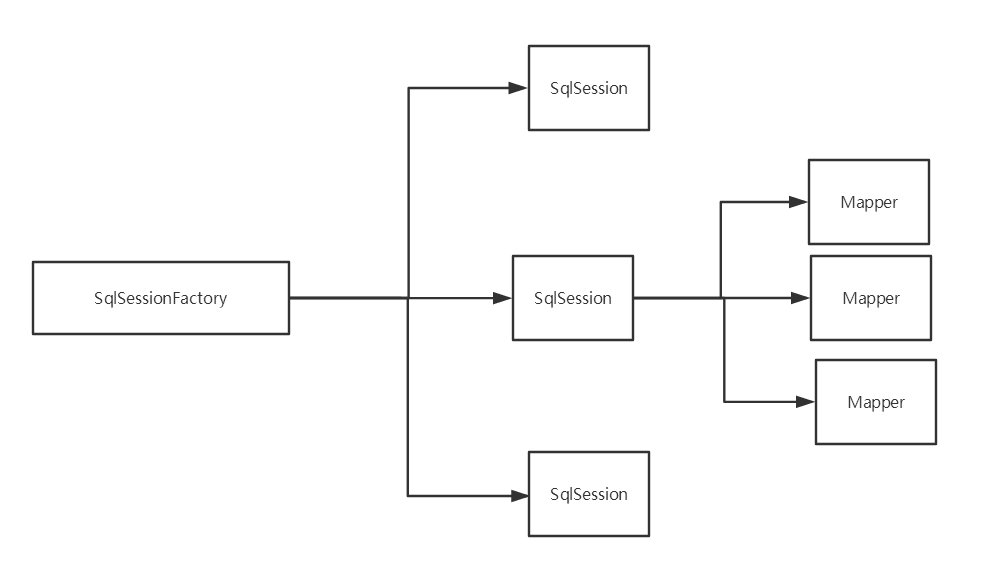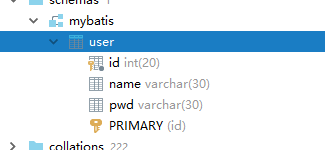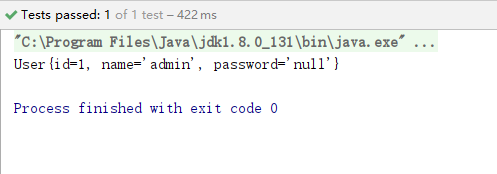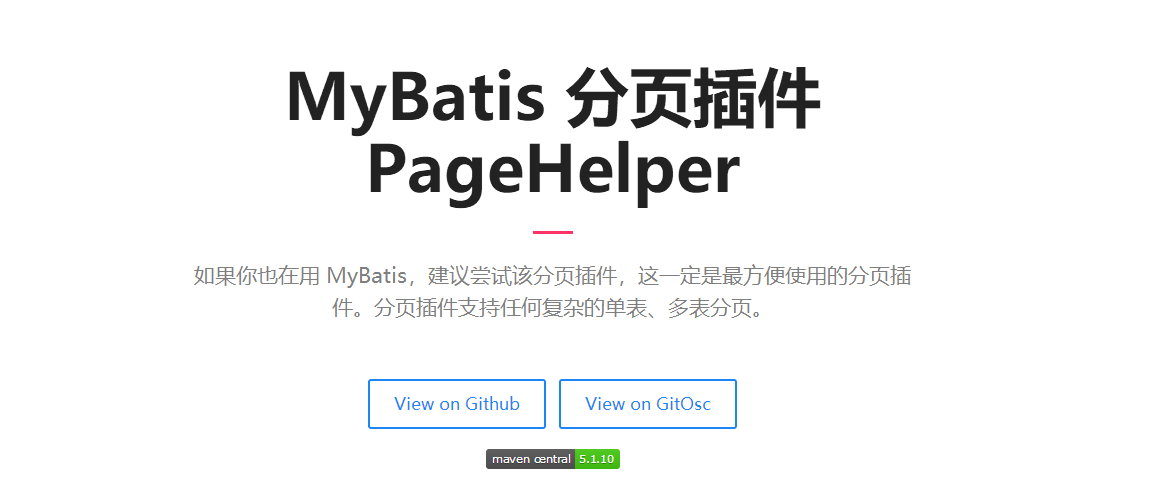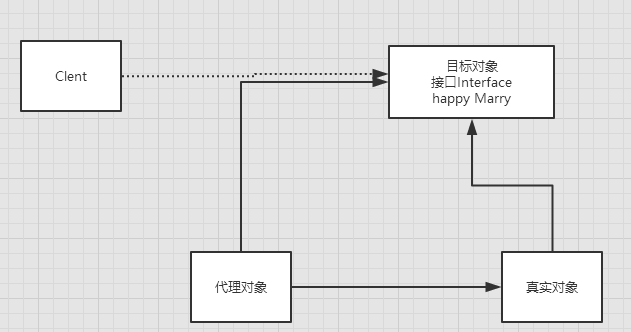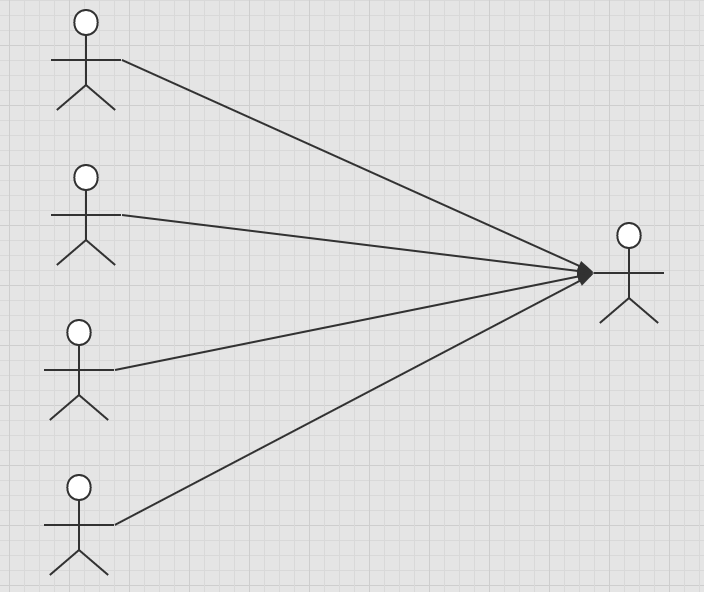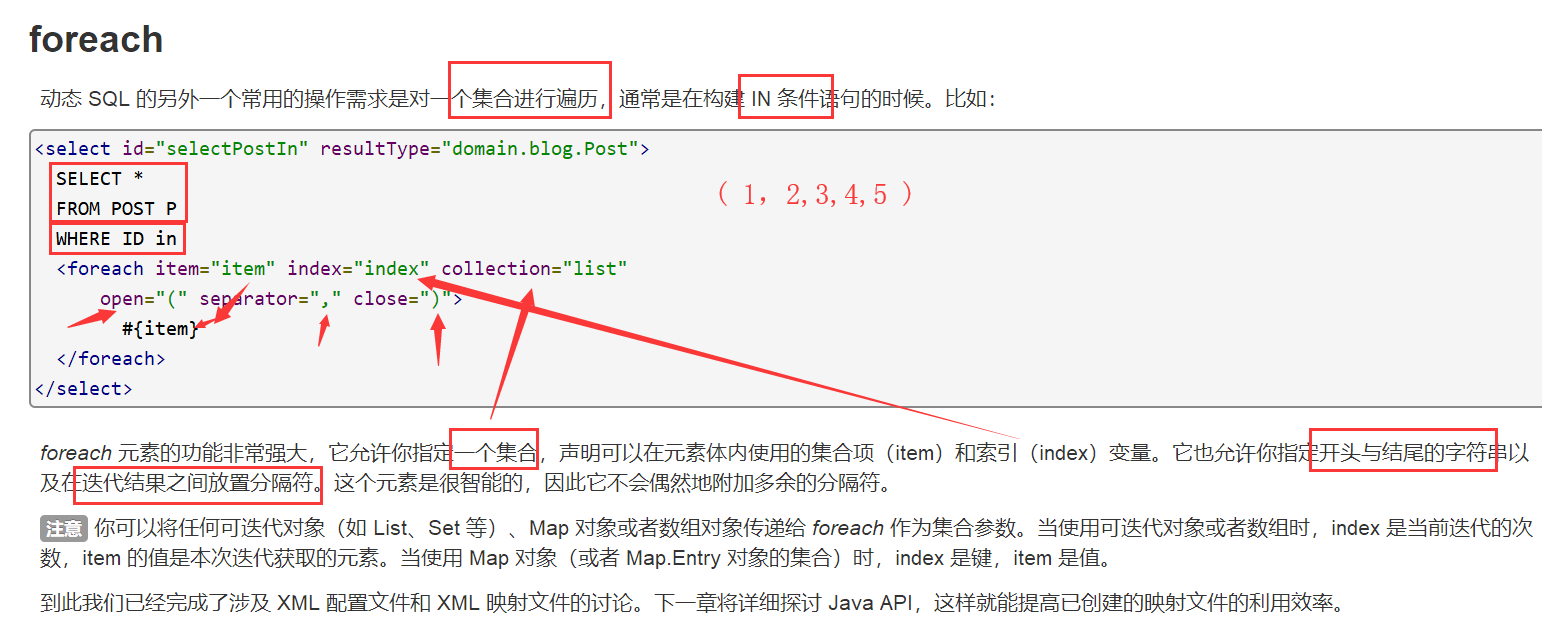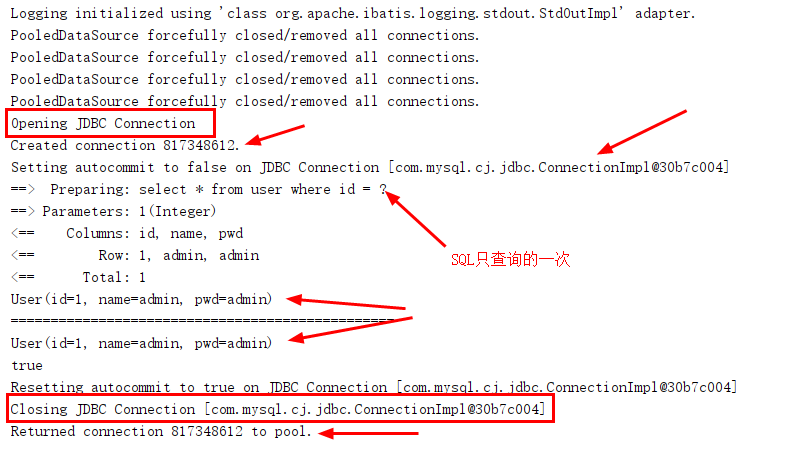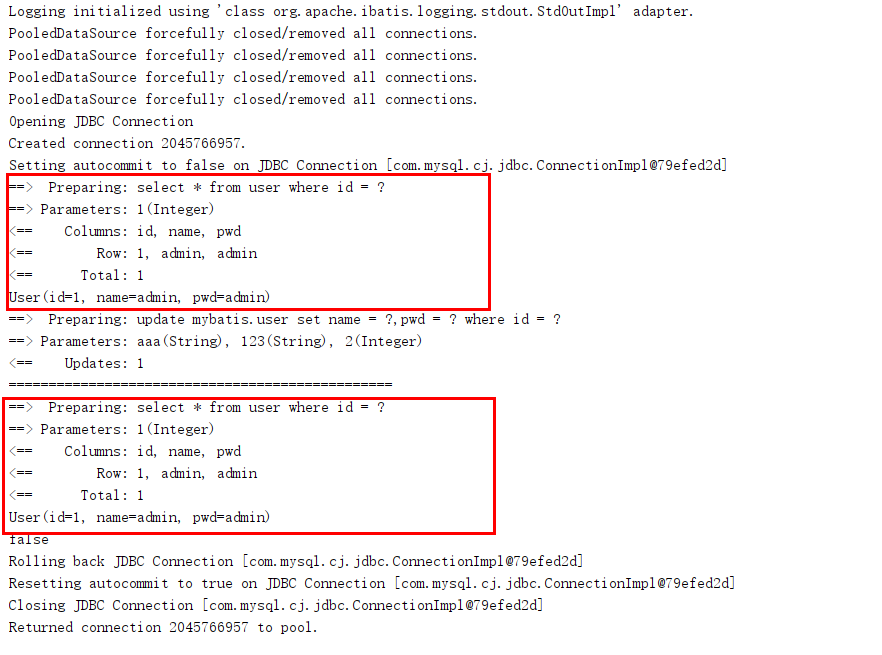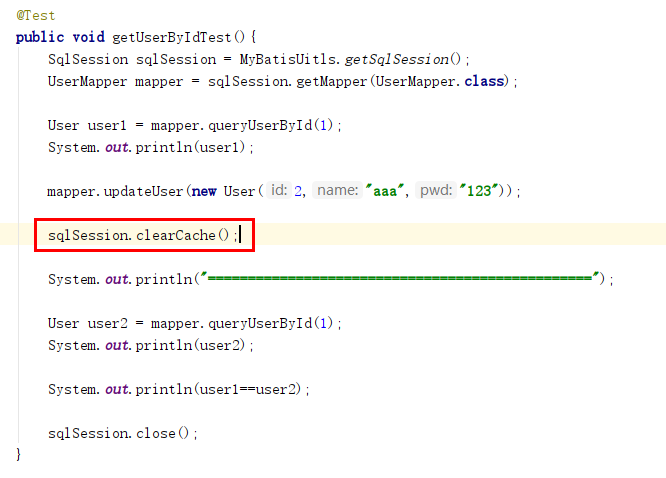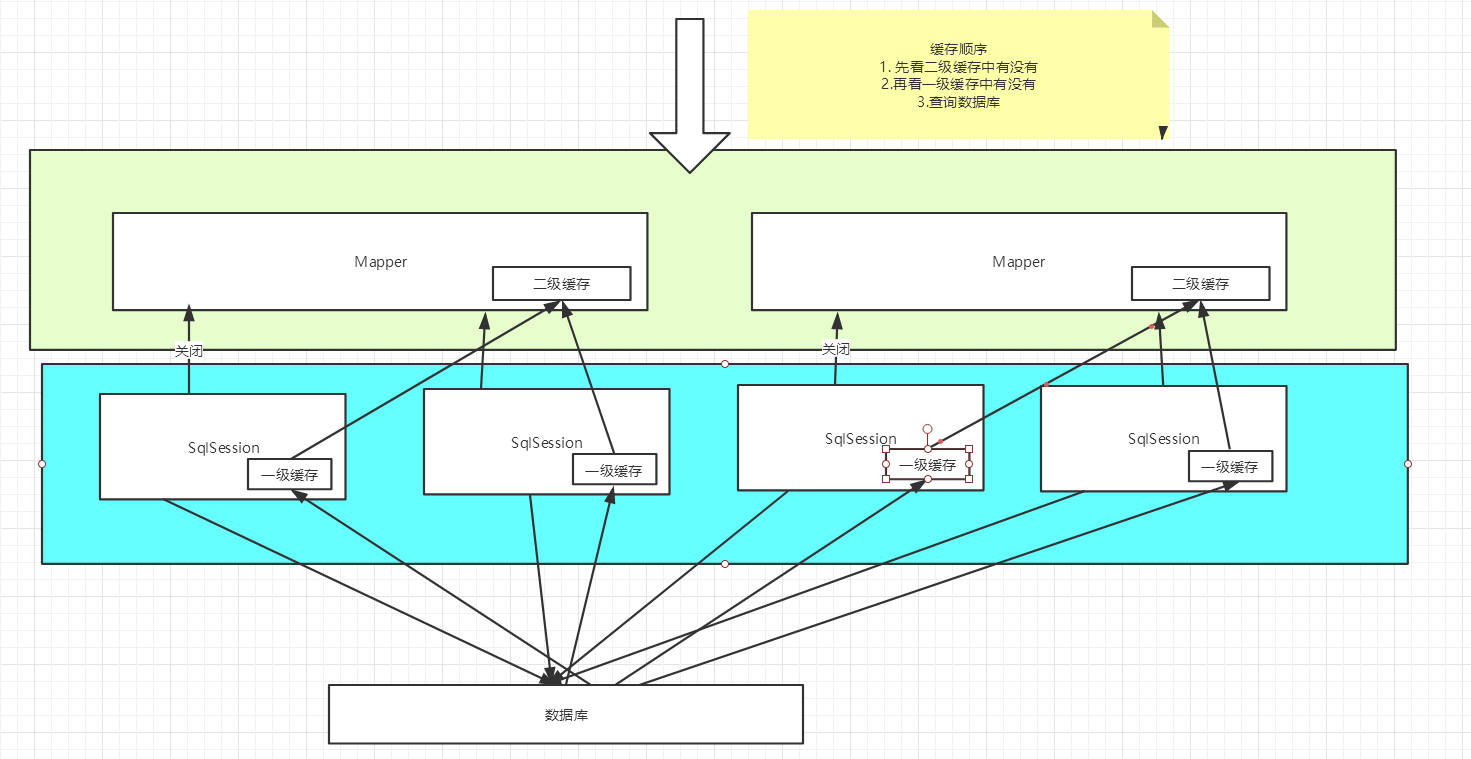MyBatis自学笔记 Mybatis-9.28 环境:
JDK1.8
Mysql 5.8
maven 3.6.1
IDEA
回顾:
JDBC
Mysql
Java基础
Maven
Junit
SSM框架:配置文件的。 最好的方式:看官网文档;
1、简介 1.1、什么是Mybatis
MyBatis 是一款优秀的持久层框架
它支持定制化 SQL、存储过程以及高级映射。
MyBatis 避免了几乎所有的 JDBC 代码和手动设置参数以及获取结果集。
MyBatis 可以使用简单的 XML 或注解来配置和映射原生类型、接口和 Java 的 POJO(Plain Old Java Objects,普通老式 Java 对象)为数据库中的记录。
MyBatis 本是apache 的一个开源项目iBatis , 2010年这个项目由apache software foundation 迁移到了google code,并且改名为MyBatis 。
2013年11月迁移到Github。
如何获得Mybatis?
1.2、持久化 数据持久化
持久化就是将程序的数据在持久状态和瞬时状态转化的过程
内存:断电即失
数据库(Jdbc),io文件持久化。
生活:冷藏. 罐头。
为什么需要需要持久化?
1.3、持久层 Dao层,Service层,Controller层….
1.4 为什么需要Mybatis?
帮助程序猿将数据存入到数据库中。
方便
传统的JDBC代码太复杂了。简化。框架。自动化。
不用Mybatis也可以。更容易上手。 技术没有高低之分
优点:
简单易学
灵活
sql和代码的分离,提高了可维护性。
提供映射标签,支持对象与数据库的orm字段关系映射
提供对象关系映射标签,支持对象关系组建维护
提供xml标签,支持编写动态sql。
最重要的一点:使用的人多!
Spring SpringMVC SpringBoot
2、第一个Mybatis程序 思路:搭建环境–>导入Mybatis–>编写代码–>测试!
2.1、搭建环境 搭建数据库
CREATE DATABASE `mybatis`; USE `mybatis`; CREATE TABLE `user`( `id` INT(20 ) NOT NULL PRIMARY KEY, `name` VARCHAR(30 ) DEFAULT NULL, `pwd` VARCHAR(30 ) DEFAULT NULL )ENGINE=INNODB DEFAULT CHARSET=utf8; INSERT INTO `user`(`id`,`name`,`pwd`) VALUES (1 ,'狂神' ,'123456' ), (2 ,'张三' ,'123456' ), (3 ,'李四' ,'123890' )
新建项目
新建一个普通的maven项目
删除src目录
导入maven依赖
<dependencies > <dependency > <groupId > mysql</groupId > <artifactId > mysql-connector-java</artifactId > <version > 8.0.25</version > </dependency > <dependency > <groupId > org.mybatis</groupId > <artifactId > mybatis</artifactId > <version > 3.5.2</version > </dependency > <dependency > <groupId > junit</groupId > <artifactId > junit</artifactId > <version > 4.12</version > <scope > test</scope > </dependency > </dependencies >
2.2、创建一个模块
编写mybatis的核心配置文件
<?xml version="1.0" encoding="UTF-8" ?> <!DOCTYPE configuration PUBLIC "-//mybatis.org//DTD Config 3.0//EN" "http://mybatis.org/dtd/mybatis-3-config.dtd" > <configuration > <environments default ="development" > <environment id ="development" > <transactionManager type ="JDBC" /> <dataSource type ="POOLED" > <property name ="driver" value ="com.mysql.cj.jdbc.Driver" /> <property name ="url" value ="jdbc:mysql://localhost:3306/mybatis?characterEncoding=utf8& useSSL=false& serverTimezone=UTC& allowPublicKeyRetrieval=true" /> <property name ="username" value ="root" /> <property name ="password" value ="132736602xm824" /> </dataSource > </environment > </environments > <mappers > <mapper resource ="com/mybatisTest/mapper/UserMapper.xml" /> </mappers > </configuration >
编写mybatis工具类
public class MyBatisUitls { private static SqlSessionFactory sqlSessionFactory; static { try { String resource = "mybatis-config.xml" ; InputStream inputStream = Resources.getResourceAsStream(resource); sqlSessionFactory = new SqlSessionFactoryBuilder ().build(inputStream); } catch (IOException e) { e.printStackTrace(); } } public static SqlSession getSqlSession () { return sqlSessionFactory.openSession(); } }
2.3、编写代码
2.4、测试 注意点:
org.apache.ibatis.binding.BindingException: Type interface com.kuang.dao.UserDao is not known to the MapperRegistry.
MapperRegistry是什么?
核心配置文件中注册 mappers
junit测试
public class UserDaoTest { @Test public void getUserLike () { SqlSession sqlSession = MyBatisUitls.getSqlSession(); UserMapper mapper = sqlSession.getMapper(UserMapper.class); List<User> userList = mapper.getUserLike("%李%" ); for (User user : userList) { System.out.println(user); } sqlSession.close(); } @Test public void getUserListTest () { SqlSession sqlSession = MyBatisUitls.getSqlSession(); try { UserMapper mapper = sqlSession.getMapper(UserMapper.class); List<User> userList = mapper.getUserList(); List<User> users = sqlSession.selectList("com.mybatisTest.mapper.UserMapper.getUserList" ); for (User user : userList) { System.out.println(user); } } catch (Exception e) { e.printStackTrace(); } finally { sqlSession.close(); } } @Test public void getUserById () { SqlSession sqlSession = MyBatisUitls.getSqlSession(); UserMapper mapper = sqlSession.getMapper(UserMapper.class); User user = mapper.getUserById(1 ); System.out.println(user.toString()); sqlSession.close(); } @Test public void addUser () { SqlSession sqlSession = MyBatisUitls.getSqlSession(); UserMapper mapper = sqlSession.getMapper(UserMapper.class); int i = mapper.addUser(new User (5 , "admins" , "admins" )); if (i > 0 ) { System.out.println("提交成功" ); } sqlSession.commit(); sqlSession.close(); } @Test public void updateUser () { SqlSession sqlSession = MyBatisUitls.getSqlSession(); UserMapper mapper = sqlSession.getMapper(UserMapper.class); int admins = mapper.updateUser(new User (3 , "admins" , "123456" )); if (admins > 0 ) { System.out.println("提交成功" ); } sqlSession.commit(); sqlSession.close(); } @Test public void deleteUser () { SqlSession sqlSession = MyBatisUitls.getSqlSession(); UserMapper mapper = sqlSession.getMapper(UserMapper.class); int i = mapper.deleteUserById(5 ); if (i > 0 ) { System.out.println("操作成功" ); } sqlSession.commit(); sqlSession.close(); } @Test public void addUsers () { SqlSession sqlSession = MyBatisUitls.getSqlSession(); UserMapper mapper = sqlSession.getMapper(UserMapper.class); HashMap<String, Object> map = new HashMap <String, Object>(); map.put("userid" , 5 ); map.put("username" , "adminmap" ); map.put("password" , "123456" ); int i = mapper.addUsers(map); if (i > 0 ) { System.out.println("提交成功" ); } sqlSession.commit(); sqlSession.close(); } }
你们可以能会遇到的问题:
配置文件没有注册
绑定接口错误。
方法名不对
返回类型不对
Maven导出资源问题(在父子pom.xml中配置以下代码)
<build> <resources> <resource> <directory>src/main/resources</directory> <includes> <include>** *.xml</include> </includes> <filtering>true </filtering> </resource> <resource> <directory>src/main/java</directory> <includes> <include>** *.xml</include> </includes> <filtering>true </filtering> </resource> </resources> </build>
3、CRUD 1、namespace namespace中的包名要和 Dao/mapper 接口的包名一致!
2、select 选择,查询语句;
id : 就是对应的namespace中的方法名;
resultType:Sql语句执行的返回值!
parameterType : 参数类型!
编写接口
User getUserById (int id) ;
编写对应的mapper中的sql语句
<select id="getUserById" parameterType="int" resultType="com.kuang.pojo.User" > select * from mybatis.user where id = #{id} </select>
测试
@Test public void getUserById () { SqlSession sqlSession = MybatisUtils.getSqlSession(); UserMapper mapper = sqlSession.getMapper(UserMapper.class); User user = mapper.getUserById(1 ); System.out.println(user); sqlSession.close(); }
3、Insert <insert id ="addUser" parameterType ="com.kuang.pojo.User" > insert into mybatis.user (id, name, pwd) values (#{id},#{name},#{pwd}); </insert >
4、update <update id ="updateUser" parameterType ="com.kuang.pojo.User" > update mybatis.user set name=#{name},pwd=#{pwd} where id = #{id} ; </update >
5、Delete <delete id ="deleteUser" parameterType ="int" > delete from mybatis.user where id = #{id}; </delete >
注意点:
6、分析错误
标签不要匹配错
resource 绑定mapper,需要使用路径!
程序配置文件必须符合规范!
NullPointerException,没有注册到资源!
输出的xml文件中存在中文乱码问题!
maven资源没有导出问题!
7、万能Map 假设,我们的实体类,或者数据库中的表,字段或者参数过多,我们应当考虑使用Map!
int addUser2 (Map<String,Object> map) ;
<insert id ="addUser" parameterType ="map" > insert into mybatis.user (id, pwd) values (#{userid},#{passWord}); </insert >
@Test public void addUser2(){ SqlSession sqlSession = MybatisUtils.getSqlSession(); UserMapper mapper = sqlSession.getMapper(UserMapper.class); Map<String, Object> map = new HashMap<String, Object>(); map.put("userid",5); map.put("passWord","2222333"); mapper.addUser2(map); sqlSession.close(); }
Map传递参数,直接在sql中取出key即可! 【parameterType=”map”】
对象传递参数,直接在sql中取对象的属性即可!【parameterType=”Object”】
只有一个基本类型参数的情况下,可以直接在sql中取到!
多个参数用Map,或者注解!
8、思考题 模糊查询怎么写?
Java代码执行的时候,传递通配符 % %
List<User> userList = mapper.getUserLike("%李%" );
在sql拼接中使用通配符!
select * from mybatis.user where name like "%" #{value}"%"
4、配置解析 1、核心配置文件
2、环境配置(environments) MyBatis 可以配置成适应多种环境
不过要记住:尽管可以配置多个环境,但每个 SqlSessionFactory 实例只能选择一种环境。
学会使用配置多套运行环境!
Mybatis默认的事务管理器就是 JDBC , 连接池 : POOLED
3、属性(properties) 我们可以通过properties属性来实现引用配置文件
这些属性都是可外部配置且可动态替换的,既可以在典型的 Java 属性文件中配置,亦可通过 properties 元素的子元素来传递。【db.properties】
编写一个配置文件
db.properties
driver =com.mysql.cj.jdbc.Driver url =jdbc:mysql://localhost:3306/racemall?characterEncoding=utf8&useSSL=false&serverTimezone=UTC&allowPublicKeyRetrieval=true username =root password =132736602xm824
在核心配置文件中映入
<properties resource ="db.properties" > <property name ="username" value ="root" /> <property name ="pwd" value ="132736602xm824" /> </properties >
可以直接引入外部文件
可以在其中增加一些属性配置
如果两个文件有同一个字段,优先使用外部配置文件的!
4、类型别名(typeAliases)
类型别名是为 Java 类型设置一个短的名字。‘
存在的意义仅在于用来减少类完全限定名的冗余。
<typeAliases > <typeAlias type ="com.mybatisTest.pojo.User" alias ="User" /> </typeAliases >
也可以指定一个包名,MyBatis 会在包名下面搜索需要的 Java Bean,比如:
扫描实体类的包,它的默认别名就为这个类的 类名,首字母小写!
<typeAliases > <package name ="com.mybatisTest.pojo" /> </typeAliases >
在实体类比较少的时候,使用第一种方式。
如果实体类十分多,建议使用第二种。
第一种可以DIY别名
第二种则·不行·,如果非要改,需要在实体上增加注解
@Alias("user") public class User {}
5、设置 这是 MyBatis 中极为重要的调整设置,它们会改变 MyBatis 的运行时行为。
6、其他配置
7、映射器(mappers) MapperRegistry:注册绑定我们的Mapper文件;
方式一: 【推荐使用】 <mappers > <mapper resource ="com/mybatisTest/mapper/UserMapper.xml" /> </mappers >
方式二:使用class文件绑定注册 <mappers > <mapper class ="com.mybatisTest.mapper.UserMapper" /> </mappers >
注意点:
接口和他的Mapper配置文件必须同名!
接口和他的Mapper配置文件必须在同一个包下!
方式三:使用扫描包进行注入绑定 <mappers > <package name ="com.kuang.dao" /> </mappers >
注意点:
接口和他的Mapper配置文件必须同名!
接口和他的Mapper配置文件必须在同一个包下!
练习时间:
将数据库配置文件外部引入
实体类别名
保证UserMapper 接口 和 UserMapper .xml 改为一致!并且放在同一个包下!
8、生命周期和作用域
生命周期,和作用域,是至关重要的,因为错误的使用会导致非常严重的并发问题 。
SqlSessionFactoryBuilder:
一旦创建了 SqlSessionFactory,就不再需要它了
局部变量
SqlSessionFactory:
说白了就是可以想象为 :数据库连接池
SqlSessionFactory 一旦被创建就应该在应用的运行期间一直存在,没有任何理由丢弃它或重新创建另一个实例。
因此 SqlSessionFactory 的最佳作用域是应用作用域。
最简单的就是使用单例模式 或者静态单例模式。
SqlSession
连接到连接池的一个请求!
SqlSession 的实例不是线程安全的,因此是不能被共享的,所以它的最佳的作用域是请求或方法作用域。
用完之后需要赶紧关闭,否则资源被占用!
这里面的每一个Mapper,就代表一个具体的业务!
5、结果集映射——属性名和字段名不一致的问题 1、 问题 数据库中的字段
新建一个项目,拷贝之前的,测试实体类字段不一致的情况
public class User { private int id; private String name; private String password; }
测试出现问题
// select * from mybatis.user where id = #{id} //类型处理器 // select id,name,pwd from mybatis.user where id = #{id}
解决方法:
起别名
<select id ="getUserList" resultType ="com.mybatisTest.pojo.User" > select id,name,pwd as password from mybatis.user </select >
2、结果集映射(resultMap) 结果集映射
id name pwd id name password
<resultMap id ="UserMap" type ="User" > <result column ="pwd" property ="password" /> </resultMap > <select id ="getUserList" resultMap ="UserMap" > select * from mybatis.user </select > <select id ="getUserById" resultMap ="UserMap" > select * from mybatis.user WHERE id = #{id} </select >
resultMap 元素是 MyBatis 中最重要最强大的元素ResultMap 的设计思想是,对于简单的语句根本不需要配置显式的结果映射,而对于复杂一点的语句只需要描述它们的关系就行了。
ResultMap 最优秀的地方在于,虽然你已经对它相当了解了,但是根本就不需要显式地用到他们。如果世界总是这么简单就好了。
6、日志 6.1、日志工厂 如果一个数据库操作,出现了异常,我们需要排错。日志就是最好的助手!
曾经:sout 、debug
现在:日志工厂!
SLF4J
LOG4J 【掌握】
LOG4J2
JDK_LOGGING
COMMONS_LOGGING
STDOUT_LOGGING 【掌握】
NO_LOGGING
在Mybatis中具体使用那个一日志实现,在设置中设定!
STDOUT_LOGGING标准日志输出
在mybatis核心配置文件中,配置我们的日志!
<settings > <setting name ="logImpl" value ="STDOUT_LOGGING" /> </settings >
6.2、Log4j 什么是Log4j?
Log4j是Apache 的一个开源项目,通过使用Log4j,我们可以控制日志信息输送的目的地是控制台 、文件、GUI 组件
我们也可以控制每一条日志的输出格式;
通过定义每一条日志信息的级别,我们能够更加细致地控制日志的生成过程。
通过一个配置文件 来灵活地进行配置,而不需要修改应用的代码。
先导入log4j的包
<dependency > <groupId > log4j</groupId > <artifactId > log4j</artifactId > <version > 1.2.17</version > </dependency >
log4j.properties
log4j.rootLogger =DEBUG,console,file log4j.appender.console = org.apache.log4j.ConsoleAppender log4j.appender.console.Target = System.out log4j.appender.console.Threshold =DEBUG log4j.appender.console.layout = org.apache.log4j.PatternLayout log4j.appender.console.layout.ConversionPattern =[%c]-%m%n log4j.appender.file = org.apache.log4j.RollingFileAppender log4j.appender.file.File =./log/kuang.log log4j.appender.file.MaxFileSize =10mb log4j.appender.file.Threshold =DEBUG log4j.appender.file.layout =org.apache.log4j.PatternLayout log4j.appender.file.layout.ConversionPattern =[%p][%d{yy-MM-dd}][%c]%m%n log4j.logger.org.mybatis =DEBUG log4j.logger.java.sql =DEBUG log4j.logger.java.sql.Statement =DEBUG log4j.logger.java.sql.ResultSet =DEBUG log4j.logger.java.sql.PreparedStatement =DEBUG
配置log4j为日志的实现
<settings > <setting name ="logImpl" value ="log4j" /> </settings >
Log4j的使用!,直接测试运行刚才的查询
简单使用
在要使用Log4j 的类中,导入包 import org.apache.log4j.Logger;
日志对象,参数为当前类的class
static Logger logger = Logger.getLogger(UserDaoTest.class);
日志级别
logger.info("info:进入了testLog4j" ); logger.debug("debug:进入了testLog4j" ); logger.error("error:进入了testLog4j" );
7、分页 思考:为什么要分页?
7.1、使用Limit分页 语法:SELECT * from user limit startIndex,pageSize; SELECT * from user limit 3 ; #[0 ,n]
使用Mybatis实现分页,核心SQL
接口
List<User> getUserByLimit (Map<String,Integer> map) ;
Mapper.xml
<select id ="getUserByLimit" parameterType ="map" resultMap ="UserMap" > select * from mybatis.user limit #{startIndex},#{pageSize}; </select >
测试
@Test public void LimitTest () { SqlSession sqlSession = MyBatisUitls.getSqlSession(); UserMapper mapper = sqlSession.getMapper(UserMapper.class); HashMap<String, Integer> map = new HashMap <String, Integer>(); map.put("startIndex" , 0 ); map.put("pageSize" , 2 ); List<User> userList = mapper.getUserByLimit(map); for (User user : userList) { System.out.println(user); } sqlSession.close(); }
7.2、RowBounds分页 不再使用SQL实现分页
接口
List<User> getUserByRowBounds () ;
mapper.xml
<select id ="getUserByRowBounds" resultMap ="UserMap" > select * from mybatis.user </select >
测试
@Test public void getUserByRowBounds () { SqlSession sqlSession = MybatisUtils.getSqlSession(); RowBounds rowBounds = new RowBounds (1 , 2 ); List<User> userList = sqlSession.selectList("com.mybatisTest.mapper.UserMapper.getUserByRowBounds" ,null ,rowBounds); for (User user : userList) { System.out.println(user); } sqlSession.close(); }
7.3、分页插件PageHelper
利用代理模式实现分页的加载
原理:
在执行SQL语句之前拦截SQL,将分页数据进行加载
pageHelper的页码为1
文档 (pagehelper.github.io)
<dependency > <groupId > com.github.pagehelper</groupId > <artifactId > pagehelper</artifactId > <version > 5.1.2</version > </dependency >
在mybatis-config.xml中配置
<plugins > <plugin interceptor ="com.github.pagehelper.pagehelper" > </plugin > </plugins >
Teachermapper.xml
<select id = "findAll" resultType ="teacher" > select * feoom `Tb_teacher` </select >
TeacherMapper
test
public void testPageAble () throws IOExceptiion { SqlSession sqlSession = MyBatisUitls.getSqlSession(); UserMapper mapper = sqlSession.getMapper(UserMapper.class); Integer page = 1 ; Integer limit = 2 ; PageHelper.startPage(page,limit); List<Teacher> all = mapper.findAll(); System.out,println(all); }
8、使用注解开发 8.1、面向接口编程 - 大家之前都学过面向对象编程,也学习过接口,但在真正的开发中,很多时候我们会选择面向接口编程
- 根本原因 : ==解耦== , 可拓展 , 提高复用 , 分层开发中 , 上层不用管具体的实现 , 大家都遵守共同的标准 , 使得开发变得容易 , 规范性更好
- 在一个面向对象的系统中,系统的各种功能是由许许多多的不同对象协作完成的。在这种情况下,各个对象内部是如何实现自己的,对系统设计人员来讲就不那么重要了;
- 而各个对象之间的协作关系则成为系统设计的关键。小到不同类之间的通信,大到各模块之间的交互,在系统设计之初都是要着重考虑的,这也是系统设计的主要工作内容。面向接口编程就是指按照这种思想来编程。
关于接口的理解
- 接口从更深层次的理解,应是定义(规范,约束)与实现(名实分离的原则)的分离。
- 接口的本身反映了系统设计人员对系统的抽象理解。
- 接口应有两类:
- 第一类是对一个个体的抽象,它可对应为一个抽象体(abstract class);
- 第二类是对一个个体某一方面的抽象,即形成一个抽象面(interface);
- 一个体有可能有多个抽象面。抽象体与抽象面是有区别的。
三个面向区别
- 面向对象是指,我们考虑问题时,以对象为单位,考虑它的属性及方法 .
- 面向过程是指,我们考虑问题时,以一个具体的流程(事务过程)为单位,考虑它的实现 .
- 接口设计与非接口设计是针对复用技术而言的,与面向对象(过程)不是一个问题.更多的体现就是对系统整体的架构
8.2、使用注解开发
注解在接口上实现
@Select("select * from user") List<User> getUsers () ;
需要再核心配置文件中绑定接口!
<mappers > <mapper class ="com.mybatisTest.mapper.UserMapper" /> </mappers >
测试
@Test public void getUsers () { SqlSession sqlSession = MyBatisUitls.getSqlSession(); UserMapper mapper = sqlSession.getMapper(UserMapper.class); List<User> users = mapper.getUsers(); for (User user : users) { System.out.println(user); } sqlSession.close(); }
本质:反射机制实现
底层:动态代理!
Mybatis详细的执行流程!
8.3、CRUD 我们可以在工具类创建的时候实现自动提交事务!
public static SqlSession getSqlSession () { return sqlSessionFactory.openSession(true ); }
编写接口,增加注解
public interface UserMapper { @Select("select * from user") List<User> getUsers () ; @Select("select * from user where id = #{id}") User getUserById (@Param("id") int id) ; @Insert("insert into user(id,name,pwd) values (#{id},#{name},#{pwd})") @Options(userGeneratedKeys = true , keyProperty = "id") int addUser (User user) ; @Update("update user set name=#{name},pwd=#{pwd} where id = #{id}") int updateUser (User user) ; @Delete("delete from user where id = #{uid}") int deleteUser (@Param("uid") int id) ; }
测试类
【注意:我们必须要将接口注册绑定到我们的核心配置文件中!】
<mappers > <mapper class ="com.mybatisTest.mapper.UserMapper" /> </mappers >
public class UserDaoTest { @Test public void getUsers () { SqlSession sqlSession = MyBatisUitls.getSqlSession(); UserMapper mapper = sqlSession.getMapper(UserMapper.class); List<User> users = mapper.getUsers(); for (User user : users) { System.out.println(user); } sqlSession.close(); } @Test public void getUserById () { SqlSession sqlSession = MyBatisUitls.getSqlSession(); UserMapper mapper = sqlSession.getMapper(UserMapper.class); User userById = mapper.getUserById(1 ); System.out.println(userById.toString()); sqlSession.close(); } @Test public void addUser () { SqlSession sqlSession = MyBatisUitls.getSqlSession(); UserMapper mapper = sqlSession.getMapper(UserMapper.class); int i = mapper.addUser(new User (0 ,"大毛" , "123" )); System.out.println(i>0 ?"插入成功" :"插入失败" ); sqlSession.commit(); sqlSession.close(); } @Test public void updateUser () { SqlSession sqlSession = MyBatisUitls.getSqlSession(); UserMapper mapper = sqlSession.getMapper(UserMapper.class); int i = mapper.updateUser(new User (0 ,"二毛" , "123" )); System.out.println(i>0 ?"修改成功" :"修改失败" ); sqlSession.commit(); sqlSession.close(); } @Test public void deleteUser () { SqlSession sqlSession = MyBatisUitls.getSqlSession(); UserMapper mapper = sqlSession.getMapper(UserMapper.class); int i = mapper.deleteUser(0 ); System.out.println(i>0 ?"删除成功" :"删除失败" ); sqlSession.commit(); sqlSession.close(); } }
关于@Param() 注解
基本类型的参数或者String类型,需要加上
引用类型不需要加
如果只有一个基本类型的话,可以忽略,但是建议大家都加上!
我们在SQL中引用的就是我们这里的 @Param() 中设定的属性名!
#{} ${} 区别
${}无法阻止sql注入问题
9、Lombok Project Lombok is a java library that automatically plugs into your editor and build tools, spicing up your java. Never write another getter or equals method again, with one annotation your class has a fully featured builder, Automate your logging variables, and much more.
java library
plugs
build tools
with one annotation your class
使用步骤:
在IDEA中安装Lombok插件!
在项目中导入lombok的jar包
<dependency > <groupId > org.projectlombok</groupId > <artifactId > lombok</artifactId > <version > 1.18.10</version > </dependency >
在实体类上加注解即可!
@Data @AllArgsConstructor @NoArgsConstructor
说明:
@Data:无参构造,get、set、tostring、hashcode,equals @AllArgsConstructor:有参构造 @NoArgsConstructor:无参构造 @EqualsAndHashCode:equals和hashcode方法 @ToString:toSting方法 @Getter and @Setter:get()、set()方法
全部注解:
@Getter and @Setter @FieldNameConstants @ToString @EqualsAndHashCode @AllArgsConstructor, @RequiredArgsConstructor and @NoArgsConstructor @Log, @Log4j, @Log4j2, @Slf4j, @XSlf4j, @CommonsLog, @JBossLog, @Flogger @Data @Builder @Singular @Delegate @Value @Accessors @Wither @SneakyThrows
写了接口,还是可以自己写内容完善
10、多表查询 10.1一对一的多表查询 <resultMap id ="orderUserResult" type ="tbOrder" > <id property ="id" column ="id" > </id > <result property ="orderPrice" column ="order_price" > </result > <result property ="userId" column ="user_id" > </result > <result property ="createTime" column ="create_time" > </result > <result property ="updateTime" column ="update_time" > </result > <associaction property ="tbUser" javaType ="tbUser" > <id property ="id" column ="id" > </id > <result property ="username" column ="user_name" > </result > <result property ="age" column ="age" > </result > <result property ="sex" column ="sex" > </result > </associaction > </resultMap > <select id ="findOrderUser" resultMap ="orderUserResult" > select * from tb_order od,tb_user tu where od.user_id=tu.id; </select >
10.2 多对一的处理 多对一:
多个学生,对应一个老师
对于学生这边而言, 关联 .. 多个学生,关联一个老师 【多对一】
对于老师而言, 集合 , 一个老师,有很多学生 【一对多】
SQL:
CREATE TABLE `teacher` ( `id` INT (10 ) NOT NULL , `name` VARCHAR (30 ) DEFAULT NULL , PRIMARY KEY (`id`) ) ENGINE= INNODB DEFAULT CHARSET= utf8 INSERT INTO teacher(`id`, `name`) VALUES (1 , '秦老师' ); CREATE TABLE `student` ( `id` INT (10 ) NOT NULL , `name` VARCHAR (30 ) DEFAULT NULL , `tid` INT (10 ) DEFAULT NULL , PRIMARY KEY (`id`), KEY `fktid` (`tid`), CONSTRAINT `fktid` FOREIGN KEY (`tid`) REFERENCES `teacher` (`id`) ) ENGINE= INNODB DEFAULT CHARSET= utf8 INSERT INTO `student` (`id`, `name`, `tid`) VALUES ('1' , '小明' , '1' ); INSERT INTO `student` (`id`, `name`, `tid`) VALUES ('2' , '小红' , '1' ); INSERT INTO `student` (`id`, `name`, `tid`) VALUES ('3' , '小张' , '1' ); INSERT INTO `student` (`id`, `name`, `tid`) VALUES ('4' , '小李' , '1' ); INSERT INTO `student` (`id`, `name`, `tid`) VALUES ('5' , '小王' , '1' );
测试环境搭建
导入lombok
新建实体类 Teacher,Student
建立Mapper接口
建立Mapper.XML文件
在核心配置文件中绑定注册我们的Mapper接口或者文件!【方式很多,随心选】
测试查询是否能够成功!
按照查询嵌套处理 <select id ="getStudent" resultMap ="student_teacher" > select * from student </select > <resultMap id ="student_teacher" type ="student" > <result property ="id" column ="id" /> <result property ="name" column ="name" /> <association property ="teacher" column ="tid" javaType ="teacher" select ="getTeacher" /> </resultMap > <select id ="getTeacher" resultType ="teacher" > select * from teacher where id = #{id} </select >
按照结果嵌套处理 <resultMap id ="student_teacher2" type ="student" > <result property ="id" column ="sid" /> <result property ="name" column ="sname" /> <association property ="teacher" javaType ="teacher" > <result property ="id" column ="tid" /> <result property ="name" column ="tname" /> </association > </resultMap > <select id ="getStudents" resultMap ="student_teacher2" > select s.id sid, s.name sname, t.id tid, t.name tname from student s, teacher t where s.tid = t.id; </select >
回顾Mysql 多对一查询方式:
10.3、一对多处理 比如:一个老师拥有多个学生!
对于老师而言,就是一对多的关系!
环境搭建
环境搭建,和刚才一样
实体类
@Data public class Student { private int id; private String name; private int tid; }
@Data public class Teacher { private int id; private String name; private List<Student> students; }
按照结果嵌套处理 <resultMap id ="teacher_student" type ="teacher" > <result property ="id" column ="tid" /> <result property ="name" column ="tname" /> <collection property ="students" ofType ="student" > <result property ="id" column ="sid" /> <result property ="name" column ="sname" /> <result property ="tid" column ="tid" /> </collection > </resultMap > <select id ="getTeacher" resultMap ="teacher_student" > select s.id sid, s.name sname, t.name tname, t.id tid from student s, teacher t where s.tid = t.id and t.id = #{tid} </select >
按照查询嵌套处理 <resultMap id ="teacher_student2" type ="teacher" > <collection property ="students" javaType ="ArrayList" ofType ="student" select ="getStudentByTeacherId" column ="id" /> </resultMap > <select id ="getStudentByTeacherId" resultType ="student" > select * from student where tid = #{tid} </select > <select id ="getTeachers" resultMap ="teacher_student2" > select * from teacher where id = #{tid} </select >
小结
关联 - association 【多对一】
集合 - collection 【一对多】
javaType & ofType
JavaType 用来指定实体类中属性的类型
ofType 用来指定映射到List或者集合中的 pojo类型,泛型中的约束类型!
注意点:
保证SQL的可读性,尽量保证通俗易懂
注意一对多和多对一中,属性名和字段的问题!
如果问题不好排查错误,可以使用日志 , 建议使用 Log4j
慢SQL 1s 1000s
面试高频
Mysql引擎 InnoDB底层原理 索引 索引优化!
多表联查 <mapper namespace ="com.qf.dao.OrderDao" > <resultMap id ="baseResult" type ="tbOrder" > <id property ="id" column ="id" > </id > <result property ="createTime" column ="create_time" > </result > <result property ="updateTime" column ="update_time" > </result > </resultMap > <select id ="findAll" resultMap ="baseResult" > SELECT * FROM `tb_order`; </select > <resultMap id ="orderUserResult" type ="tbOrder" > <id property ="id" column ="id" > </id > <result property ="orderPrice" column ="order_price" > </result > <result property ="userId" column ="user_id" > </result > <result property ="createTime" column ="create_time" > </result > <result property ="updateTime" column ="update_time" > </result > <association property ="tbUser" javaType ="tbUser" > <id column ="id" property ="id" > </id > <result column ="user_name" property ="userName" > </result > <result column ="age" property ="age" > </result > <result column ="sex" property ="sex" > </result > </association > </resultMap > <select id ="findOrderUser" resultMap ="orderUserResult" > select * from tb_order od,tb_user tu where od.user_id=tu.id ; </select > <resultMap id ="orderDetailResult" type ="tbOrder" > <id property ="id" column ="id" > </id > <result property ="orderPrice" column ="order_price" > </result > <result property ="userId" column ="user_id" > </result > <result property ="createTime" column ="create_time" > </result > <result property ="updateTime" column ="update_time" > </result > <association property ="tbUser" javaType ="tbUser" > <id column ="id" property ="id" > </id > <result column ="user_name" property ="userName" > </result > <result column ="age" property ="age" > </result > <result column ="sex" property ="sex" > </result > </association > <collection property ="tbOrderDetailList" ofType ="tbOrderDetail" > <id property ="orderDetailId" column ="order_detail_id" > </id > <result property ="orderDetailPrice" column ="order_detail_price" > </result > <result property ="shopId" column ="shop_id" > </result > <result property ="createTime" column ="create_time" > </result > </collection > </resultMap > <select id ="findOrderAndOrderDetails" resultMap ="orderDetailResult" > SELECT * FROM tb_order od,`tb_order_detail` tod,tb_user tu where od.user_id=tu.id and od.id=tod.order_id; </select > <resultMap id ="orderDetailShopsResult" type ="tbOrder" > <id property ="id" column ="id" > </id > <result property ="orderPrice" column ="order_price" > </result > <result property ="userId" column ="user_id" > </result > <result property ="createTime" column ="create_time" > </result > <result property ="updateTime" column ="update_time" > </result > <association property ="tbUser" javaType ="tbUser" > <id column ="id" property ="id" > </id > <result column ="user_name" property ="userName" > </result > <result column ="age" property ="age" > </result > <result column ="sex" property ="sex" > </result > </association > <collection property ="tbOrderDetailList" ofType ="tbOrderDetail" > <id property ="orderDetailId" column ="order_detail_id" > </id > <result property ="orderDetailPrice" column ="order_detail_price" > </result > <result property ="shopId" column ="shop_id" > </result > <result property ="createTime" column ="create_time" > </result > <association property ="tbShop" javaType ="tbShop" > <id property ="shopId" column ="shop_id" > </id > <result property ="shopName" column ="shop_name" > </result > <result property ="shopDes" column ="shop_des" > </result > <result property ="shopPrice" column ="shop_price" > </result > </association > </collection > </resultMap > <select id ="findOrderAndOrderDetailAnShop" resultMap ="orderDetailShopsResult" > SELECT * FROM tb_order od,`tb_order_detail` tod,tb_user tu,tb_shop ts where od.user_id=tu.id and od.id=tod.order_id and tod.shop_id=ts.shop_id; </select > </mapper >
SQLMapper.xml文件 <mapper namespace =“” > <resultMap id ="" type ="" > <id column ="" property ="" > </id > <result column ="" property ="" > </result > <constructor > <idArg column ="" javaType ="" > </idArg > <arg column ="" javaType ="" > </arg > </constructor > <association property ="" javaType ="" > <id > </id > <result > </result > ... </association > <collection property ="" ofType ="" > </collection > </resultMap > <select id ="" paramaterType =“” resultType /resultMap ="" > </select > <insert id =“” paramterType ="" useGeneratedKeys ="true" keyProperty ="id" > </insert > <update id ="" paramterType ="" > </update > <delete id ="" paramterType ="" > </delete > </mapper >
userGeneratedKeys 可以获取到刚刚添加到数据库中的最新一条信息的ID(仅作用于id自增的情况下)
一张表中对两个事务同时进行操作:
先添加一个Class,再添加一个Teacher,其中Teacher中有ClassId
ClassMapper.xml
<insert id ="insertClasses" parameterType ="tbClasses" useGeneratedKeys ="true" keyProperty ="id" > insert into tb_classes (id,class_name,class_addr) values (null,#{className},#{classAddr}) </insert >
TeacherMapper.xml
<insert id ="insertTeacher" parameterType ="toTeacher" userGeneratedKeys ="true" keyProperty ="id" > insert into tb_teacher(id.teacher_name,age,sex,class_id) values (null,#{teacherName},#{age},#{sex},#{classId}) </insert >
测试文件
public void testGeneraId () throws IOException { String path="mybatis-config.xml" ; InputStream resourceAsStream = Resources.getResourceAsStream(path); SqlSessionFactory build = new SqlSessionFactoryBuilder ().build(resourceAsStream); SqlSession sqlSession = build.openSession(true ); ClassesDao mapperc = sqlSession.getMapper(ClassesDao.class); TbClasses tbClasses = new TbClasses (); tbClasses.setClassName("javaee2108" ); tbClasses.setClassAddr("教6" ); int i = mapperc.insertClasses(tbClasses); System.out.println("影响的行数为====" +i); System.out.println("新增的id为===" +tbClasses.getId()); TeacherDao mappert = sqlSession.getMapper(TeacherDao.class); TbTeacher tbTeacher = new TbTeacher (); tbTeacher.setTeacherName("ajax" ); tbTeacher.setAge(19 ); tbTeacher.setSex("女" ); tbTeacher.setClassId(tbClasses.getId()); mappert.insertTeacher(tbTeacher); }
12、动态 SQL 什么是动态SQL:动态SQL就是指根据不同的条件生成不同的SQL语句
利用动态 SQL 这一特性可以彻底摆脱这种痛苦。
动态 SQL 元素和 JSTL 或基于类似 XML 的文本处理器相似。在 MyBatis 之前的版本中,有很多元素需要花时间了解。MyBatis 3 大大精简了元素种类,现在只需学习原来一半的元素便可。MyBatis 采用功能强大的基于 OGNL 的表达式来淘汰其它大部分元素。 if choose (when, otherwise) trim (where, set) foreach
搭建环境 CREATE TABLE `blog` ( `id` varchar (50 ) NOT NULL COMMENT '博客id' , `title` varchar (100 ) NOT NULL COMMENT '博客标题' , `author` varchar (30 ) NOT NULL COMMENT '博客作者' , `create_time` datetime NOT NULL COMMENT '创建时间' , `views` int (30 ) NOT NULL COMMENT '浏览量' ) ENGINE= InnoDB DEFAULT CHARSET= utf8
创建一个基础工程
导包
编写配置文件
编写实体类
@Data public class Blog { private int id; private String title; private String author; private Date createTime; private int views; }
编写实体类对应Mapper接口 和 Mapper.XML文件
添加信息
<insert id ="addBlog" parameterType ="blog" > insert into mybatis.blog (id, title, author, create_time, views) VALUES (#{id}, #{title}, #{author}, #{createTime}, #{views}) </insert >
@Test public void addBlog () { SqlSession sqlSession = MyBatisUitls.getSqlSession(); BlogMapper mapper = sqlSession.getMapper(BlogMapper.class); Blog blog = new Blog (); blog.setId(IDUtils.getId()); blog.setTitle("Mybatis" ); blog.setAuthor("薛三水" ); blog.setCreateTime(new Date ()); blog.setViews(9999 ); mapper.addBlog(blog); blog.setId(IDUtils.getId()); blog.setTitle("Java" ); mapper.addBlog(blog); blog.setId(IDUtils.getId()); blog.setTitle("Spring" ); mapper.addBlog(blog); blog.setId(IDUtils.getId()); blog.setTitle("微服务" ); mapper.addBlog(blog); sqlSession.commit(); sqlSession.close(); }
IF <select id ="queryBlogIF" parameterType ="map" resultType ="blog" > select * from mybatis.blog where 1=1 <if test ="title != null and title!= ''" > and title = #{title} </if > <if test ="author != null and author != ''" > and author = #{author} </if > </select >
@Test public void queryBlogIF () { SqlSession sqlSession = MyBatisUitls.getSqlSession(); BlogMapper mapper = sqlSession.getMapper(BlogMapper.class); HashMap map = new HashMap (); map.put("title" ,"Java" ); map.put("author" ,"薛三水" ); List<Blog> blogs = mapper.queryBlogIF(map); for (Blog blog : blogs) { System.out.println(blog); } sqlSession.close(); }
> > 大于符号
< < 小于符号
choose (when, otherwise) <select id ="queryBlogChoose" parameterType ="map" resultType ="blog" > select * from mybatis.blog <where > <choose > <when test ="title != null and title != ''" > and title = #{title} </when > <when test ="author != null and author != ''" > and author = #{author} </when > <otherwise > and views = #{views} </otherwise > </choose > </where > </select >
@Test public void queryBlogChoose () { SqlSession sqlSession = MyBatisUitls.getSqlSession(); BlogMapper mapper = sqlSession.getMapper(BlogMapper.class); HashMap map = new HashMap (); map.put("title" , "Java" ); map.put("author" , "薛三水" ); map.put("views" ,9999 ); List<Blog> blogs = mapper.queryBlogIF(map); for (Blog blog : blogs) { System.out.println(blog); } sqlSession.close(); }
trim (where,set) set
<update id ="updateBlog" parameterType ="map" > update mybatis.blog <set > <if test ="title != null and title != ''" > title = #{title}, </if > <if test ="author != null amd author != ''" > author = #{author} </if > <if test ="views != null and views != ''" > views = #{views} </if > </set > where id =#{id} </update >
@Test public void updateBlog () { SqlSession sqlSession = MyBatisUitls.getSqlSession(); BlogMapper mapper = sqlSession.getMapper(BlogMapper.class); HashMap map = new HashMap (); map.put("views" ,1000 ); map.put("id" ,"cedc8e28b90b46288f52a8d87017a6b6" ); mapper.updateBlog(map); sqlSession.commit(); sqlSession.close(); }
trim
<insert id ="insertBlog" parameterType ="map" > insert into mybatis.blog <trime prefix ="(" suffix =")" suffixOverrides ="," > <if test ="title != null and title != ''" > title, </if > <if test ="author != null amd author != ''" > author, </if > <if test ="views != null and views != ''" > views, </if > </trim > <trime prefix =" values(" suffix =")" suffixOverrides ="," > <if test ="title != null and title != ''" > #{title}, </if > <if test ="author != null amd author != ''" > #{author}, </if > <if test ="views != null and views != ''" > #{views}, </if > </trim > where id =#{id} </update >
@Test public void updateBlog () { SqlSession sqlSession = MyBatisUitls.getSqlSession(); BlogMapper mapper = sqlSession.getMapper(BlogMapper.class); HashMap map = new HashMap (); map.put("views" ,1000 ); map.put("id" ,"cedc8e28b90b46288f52a8d87017a6b6" ); mapper.insertBlog(map); sqlSession.commit(); sqlSession.close(); }
所谓的动态SQL,本质还是SQL语句 , 只是我们可以在SQL层面,去执行一个逻辑代码
if
where , set , choose ,when
SQL片段 有的时候,我们可能会将一些功能的部分抽取出来,方便复用!
使用SQL标签抽取公共的部分
<sql id ="if-title-author" > <if test ="title != null & title != ''" > title = #{title} </if > <if test ="author != null & author != ''" > and author = #{author} </if > </sql >
在需要使用的地方使用Include标签引用即可
<select id ="queryBlogIF" parameterType ="map" resultType ="blog" > select * from mybatis.blog <where > <include refid ="if-title-author" > </include > </where > </select >
注意事项:
最好基于单表来定义SQL片段!
不要存在where标签
Foreach select * from user where 1=1 and <foreach item ="id" collection ="ids" open ="(" separator ="or" close =")" > #{id} </foreach > (id=1 or id=2 or id=3)
<select id ="queryBlogForEach" parameterType ="map" resultType ="blog" > select * from mybatis.blog <where > <foreach collection ="ids" item ="id" open ="and (" close =")" separator ="or" > id=#{id} </foreach > </where > </select >
@Test public void queryBlogForEach () { SqlSession sqlSession = MyBatisUitls.getSqlSession(); BlogMapper mapper = sqlSession.getMapper(BlogMapper.class); HashMap map = new HashMap (); ArrayList<String> ids = new ArrayList <String>(); ids.add("cedc8e28b90b46288f52a8d87017a6b6" ); ids.add("c829bfe1826f4a62a1aae95e78f17878" ); ids.add("aeeccb3082f9484083826ca70502edec" ); map.put("ids" ,ids); List<Blog> blogs = mapper.queryBlogForEach(map); for (Blog blog : blogs) { System.out.println(blog); } sqlSession.close(); }
index:下标
item:内容
open:以什么开头
close:以什么关闭
separator:以什么分割
批量新增
<insert id ="insertAll" > insert into tb_shop(shop_id,shop_name,shop_des,shop_price)VALUES <foreach collection ="list" item ="item" open ="(" separator ="," close =")" > (#{null},#{item.shopName},#{item.shopDes},#{item.shopPrice}) </foreach > </insert >
@Test public void testForeachInsert () throws IOException { String path="mybatis-config.xml" ; InputStream resourceAsStream = Resources.getResourceAsStream(path); SqlSessionFactory build = new SqlSessionFactoryBuilder ().build(resourceAsStream); SqlSession sqlSession = build.openSession(true ); ShopDao mapper = sqlSession.getMapper(ShopDao.class); List list = new ArrayList (); for (int i = 0 ;i<10 ;i++){ TbShop tbShop = new TbShop (); tbShop.setShopName("小米" +i); tbShop.setShopDes("小米第" +i+"袋" ); tbShop.setShopPrice(Double.valueOf(i)); list.add(tbShop); } int i = mapper.insertAll(list); System.out.println(i); }
批量删除
<delete id ="deleteById" > delete from tb_shop <where > shop_id in </where > <foreach collection- "list " item ="item" item ="item" open ="(" separator ="," close =")" > #{item} </foreach > </delete >
@Test public void testForeach () throws IOException { String path="mybatis-config.xml" ; InputStream resourceAsStream = Resources.getResourceAsStream(path); SqlSessionFactory build = new SqlSessionFactoryBuilder ().build(resourceAsStream); SqlSession sqlSession = build.openSession(true ); ShopDao mapper = sqlSession.getMapper(ShopDao.class); List list = new ArrayList (); list.add(1 ); list.add(2 ); list.add(3 ); int i = mapper.deleteByIds(list); System.out.println(i); }
动态SQL就是在拼接SQL语句,我们只要保证SQL的正确性,按照SQL的格式,去排列组合就可以了
建议:
先在Mysql中写出完整的SQL,再对应的去修改成为我们的动态SQL实现通用即可!
13、缓存 (了解) 13.1、简介 查询 : 连接数据库 ,耗资源! 一次查询的结果,给他暂存在一个可以直接取到的地方!--> 内存 : 缓存 我们再次查询相同数据的时候,直接走缓存,就不用走数据库了
什么是缓存 [ Cache ]?
存在内存中的临时数据。
将用户经常查询的数据放在缓存(内存)中,用户去查询数据就不用从磁盘上(关系型数据库数据文件)查询,从缓存中查询,从而提高查询效率,解决了高并发系统的性能问题。
为什么使用缓存?
减少和数据库的交互次数,减少系统开销,提高系统效率。
什么样的数据能使用缓存?
13.2、Mybatis缓存
MyBatis包含一个非常强大的查询缓存特性,它可以非常方便地定制和配置缓存。缓存可以极大的提升查询效率。
MyBatis系统中默认定义了两级缓存:一级缓存 和二级缓存
默认情况下,只有一级缓存开启。(SqlSession级别的缓存,也称为本地缓存)
二级缓存需要手动开启和配置,他是基于namespace级别的缓存。
为了提高扩展性,MyBatis定义了缓存接口Cache。我们可以通过实现Cache接口来自定义二级缓存
13.3、一级缓存
一级缓存也叫本地缓存: SqlSession
与数据库同一次会话期间查询到的数据会放在本地缓存中。
以后如果需要获取相同的数据,直接从缓存中拿,没必须再去查询数据库;
测试步骤:
开启日志!
测试在一个Session中查询两次相同记录
查看日志输出
缓存失效的情况:
查询不同的东西
增删改操作,可能会改变原来的数据,所以必定会刷新缓存!
查询不同的Mapper.xml
手动清理缓存!
小结:一级缓存默认是开启的,只在一次SqlSession中有效,也就是拿到连接到关闭连接这个区间段!
一级缓存就是一个Map。
13.4、二级缓存
二级缓存也叫全局缓存,一级缓存作用域太低了,所以诞生了二级缓存
基于namespace级别的缓存,一个名称空间,对应一个二级缓存;
工作机制
一个会话查询一条数据,这个数据就会被放在当前会话的一级缓存中;
如果当前会话关闭了,这个会话对应的一级缓存就没了;但是我们想要的是,会话关闭了,一级缓存中的数据被保存到二级缓存中;
新的会话查询信息,就可以从二级缓存中获取内容;
不同的mapper查出的数据会放在自己对应的缓存(map)中;
步骤:
开启全局缓存
<setting name ="cacheEnabled" value ="true" />
在要使用二级缓存的Mapper中开启
在查询中使用二级缓存
<select id ="queryUserById" resultType ="user" useCache ="true" > select * from user where id = #{id} </select >
也可以自定义参数
<cache eviction ="FIFO" flushInterval ="60000" size ="512" readOnly ="true" />
测试
当没有开启二级缓存时,会自动查询两次
<select id ="queryUserById" resultType ="user" useCache ="true" > select * from user where id = #{id} </select >
@Test public void getUserByIdTest () { SqlSession sqlSession1 = MyBatisUitls.getSqlSession(); SqlSession sqlSession2 = MyBatisUitls.getSqlSession(); UserMapper mapper1 = sqlSession1.getMapper(UserMapper.class); UserMapper mapper2 = sqlSession2.getMapper(UserMapper.class); User user1 = mapper1.queryUserById(1 ); System.out.println(user1); User user2 = mapper2.queryUserById(1 ); System.out.println(user2); sqlSession1.close(); sqlSession2.close(); }
添加二级缓存后,只查询一次,第二次查询在缓存中查找
<cache eviction ="FIFO" flushInterval ="60000" size ="512" readOnly ="true" /> <select id ="queryUserById" resultType ="user" useCache ="true" > select * from user where id = #{id} </select >
@Test public void getUserByIdTest () { SqlSession sqlSession1 = MyBatisUitls.getSqlSession(); SqlSession sqlSession2 = MyBatisUitls.getSqlSession(); UserMapper mapper1 = sqlSession1.getMapper(UserMapper.class); User user1 = mapper1.queryUserById(1 ); System.out.println(user1); sqlSession1.close(); UserMapper mapper2 = sqlSession2.getMapper(UserMapper.class); User user2 = mapper2.queryUserById(1 ); System.out.println(user2); sqlSession2.close(); }
问题:我们需要将实体类序列化!否则就会报错!
@Data @NoArgsConstructor @AllArgsConstructor public class User implements Serializable { private int id; private String name; private String pwd; }
Caused by: java.io.NotSerializableException: com.mybatis.pojo.User
小结:
只要开启了二级缓存,在同一个Mapper下就有效
所有的数据都会先放在一级缓存中;
只有当会话提交,或者关闭的时候,才会提交到二级缓冲中!
13.5、缓存原理
13.6、自定义缓存-ehcache Ehcache是一种广泛使用的开源Java分布式缓存。主要面向通用缓存
要在程序中使用ehcache,先要导包!
<dependency > <groupId > org.mybatis.caches</groupId > <artifactId > mybatis-ehcache</artifactId > <version > 1.1.0</version > </dependency >
在mapper中指定使用我们的ehcache缓存实现!
<cache type ="org.mybatis.caches.ehcache.EhcacheCache" />
ehcache.xml
<?xml version="1.0" encoding="UTF-8" ?> <ehcache xmlns:xsi ="http://www.w3.org/2001/XMLSchema-instance" xsi:noNamespaceSchemaLocation ="http://ehcache.org/ehcache.xsd" updateCheck ="false" > <diskStore path ="./tmpdir/Tmp_EhCache" /> <defaultCache eternal ="false" maxElementsInMemory ="10000" overflowToDisk ="false" diskPersistent ="false" timeToIdleSeconds ="1800" timeToLiveSeconds ="259200" memoryStoreEvictionPolicy ="LRU" /> <cache name ="cloud_user" eternal ="false" maxElementsInMemory ="5000" overflowToDisk ="false" diskPersistent ="false" timeToIdleSeconds ="1800" timeToLiveSeconds ="1800" memoryStoreEvictionPolicy ="LRU" /> </ehcache >
Redis数据库来做缓存! K-V
14、#{}和${}的区别
#{}相当于prepareStatement预编译对象,以?作为占位符,先编译再赋值,可以防止sql注入
${}相当于statement,直接进行值的替换
但是 ${}不能删除,因为当数据量到达一定级别后,需要进行分表的操作,分表分为纵向分割,横向分割,不管哪种分割方式,都会导致,在SQLMapper.xml中的表名不能写死,需要进行传入。就需要使用${}进行分表名的传输
<select id ="findByTeacherName" resultMap ="baseResult" > select * from ${tableName} where teacher_name = ${tracherName} </select >
测试类
public interface TeacherDap { int insertTeacher (TbTeacher tbTeacher) ; List<TbTeacher> findByTeacherName (@Param("tableName") String table,@Param("teacherName") String teacherName) ; }
课堂笔记 完整的CRUD community.java
import lombok.Data;import lombok.ToString;import java.io.Serializable;import java.util.Date;@Data @ToString public class Community implements Serializable { private Integer id; private String communityNum; private String name; private String address; private Double communityArea; private Integer buildingNum; private Integer roomNum; private Integer greeningRate; private String img; private String developerName; private String propertyName; private Date hiredate; private Integer state; private Integer uid; }
communityMapper.java
import com.example.bean.Community;import org.apache.ibatis.annotations.Param;import java.util.List;import java.util.Map;public interface CommunityMapper { public List<Community> selectAll () ; public int insert1 (Community community) ; public int insert2 (Community community) ; public int delById (Integer id) ; public int delByIds1 (List<Integer> ids) ; public int delByIds2 (Integer[] ids) ; public int delByIds3 (Map map) ; public int delByParam1 (String name,String address) ; public int delByParam2 (@Param("name") String name, @Param("address") String address) ; public int update (Community community) ; }
<?xml version="1.0" encoding="UTF-8" ?> <!DOCTYPE mapper PUBLIC "-//mybatis.org//DTD Mapper 3.0//EN" "http://mybatis.org/dtd/mybatis-3-mapper.dtd" > <mapper namespace ="com.qfedu.dao.CommunityMapper" > <select id ="selectAll" resultType ="community" > select * from db_community </select > <insert id ="insert1" parameterType ="community" useGeneratedKeys ="true" keyColumn ="id" keyProperty ="id" > insert into db_community( id ,communityNum ,name ,address ,communityArea ,buildingNum ,roomNum ,img ,greeningRate ,developerName ,propertyName ,hiredate ,state ,uid ) values( null ,#{communityNum,jdbcType=VARCHAR} ,#{name,jdbcType=VARCHAR} ,#{address,jdbcType=VARCHAR} ,#{communityArea,jdbcType=DOUBLE} ,#{buildingNum,jdbcType=INTEGER} ,#{roomNum,jdbcType=INTEGER} ,#{img,jdbcType=VARCHAR} ,#{greeningRate,jdbcType=INTEGER} ,#{developerName,jdbcType=VARCHAR} ,#{propertyName,jdbcType=VARCHAR} ,#{hiredate,jdbcType=DATE} ,#{state,jdbcType=INTEGER} ,#{uid,jdbcType=INTEGER} ); </insert > <insert id ="insert2" parameterType ="community" > <selectKey keyColumn ="id" keyProperty ="id" order ="AFTER" resultType ="INTEGER" > SELECT LAST_INSERT_ID() </selectKey > insert into db_community <trim prefix ="(" suffix =")" suffixOverrides ="," > <if test ="communityNum!=null and communityNum!=''" > communityNum, </if > <if test ="name!=null and name!=''" > name, </if > <if test ="buildingNum!=null" > buildingNum, </if > </trim > <trim prefix =" values(" suffix =")" suffixOverrides ="," > <if test ="communityNum!=null and communityNum!=''" > #{communityNum}, </if > <if test ="name!=null and name!=''" > #{name}, </if > <if test ="buildingNum!=null" > #{buildingNum}, </if > </trim > </insert > <delete id ="delById" parameterType ="java.lang.Integer" > delete from db_community where id=#{id}; </delete > <delete id ="delByIds1" parameterType ="java.util.ArrayList" > delete from db_community where id in <foreach collection ="list" open ="(" close =")" separator ="," item ="id" > #{id} </foreach > </delete > <delete id ="delByIds2" > delete from db_community where id in <foreach collection ="array" open ="(" close =")" separator ="," item ="id" > #{id} </foreach > </delete > <delete id ="delByIds3" parameterType ="java.util.HashMap" > delete from db_community where id =#{id1} or id=#{id2}; </delete > <delete id ="delByParam1" > delete from db_community where name=#{param1} and address=#{param2} </delete > <delete id ="delByParam2" > delete from db_community where name=#{name} and address=#{address} </delete > <update id ="update" parameterType ="community" > update db_community <set > <if test ="name!=null and name!=''" > name=#{name}, </if > <if test ="address!=null and address!=''" > address=#{address}, </if > </set > where id=#{id} </update > </mapper >
条件分页查询 public List<Community> selectByPage () ;public List<Community> selectByPage1 (CommunityVo vo) ;
<select id ="selectByPage" resultMap ="baseResultMap" > select * from db_community </select > <select id ="selectByPage1" resultMap ="baseResultMap" > select * from db_community <where > <if test ="name!=null and name!=''" > name like '${name}' </if > </where > </select >
@Test public void selectByPage () { CommunityMapper mapper = MyBatisUtils.getMapper(CommunityMapper.class); PageHelper.startPage(1 ,3 ); List<Community> list = mapper.selectByPage(); Page<Community> page = (Page)list; List<Community> result = page.getResult(); System.out.println(result); PageInfo<Community> pageInfo = new PageInfo <>(list); List<Community> list1 = pageInfo.getList(); System.out.println(list1); MyBatisUtils.closeSqlSssion(); } @Test public void selectByPage1 () { CommunityMapper mapper = MyBatisUtils.getMapper(CommunityMapper.class); PageHelper.startPage(1 ,3 ); CommunityVo vo = new CommunityVo (); vo.setName("%123%' or 1=1 or name='1" ); List<Community> communities = mapper.selectByPage1(vo); PageInfo<Community> pageInfo = new PageInfo <>(communities); System.out.println(pageInfo); }
多表查询 准备工作 Community.java
@Data @ToString public class Community implements Serializable { private Integer id; private String communityNum; private String name; private String address; private Double communityArea; private Integer buildingNum; private Integer roomNum; private Integer greeningRate; private String img; private String developerName; private String propertyName; private Date hiredate; private Integer state; private Integer uid; private List<Equipment> equipmentList; }
CommunityVo.java
@Data @ToString public class CommunityVo implements Serializable { private Date startTime; private Date endTime; private String name; private int page; private int limit; }
Equipment.java
@Data @ToString public class Equipment implements Serializable { private Integer id; private Integer cid; private String cname; private String eno; private String ename; private String ebrand; private double eprice; private Integer enumber; private Date salldate; private String vailyear; private Integer ifdelete; private Date createtime; private Community community; }
mybatis.xml
<?xml version="1.0" encoding="UTF-8" ?> <!DOCTYPE configuration PUBLIC "-//mybatis.org//DTD Config 3.0//EN" "http://mybatis.org/dtd/mybatis-3-config.dtd" > <configuration > <properties resource ="mysql.properties" /> <settings > <setting name ="logImpl" value ="STDOUT_LOGGING" /> <setting name ="mapUnderscoreToCamelCase" value ="true" /> <setting name ="cacheEnabled" value ="true" /> </settings > <typeAliases > <package name ="com.mybatisTest.pojo" /> </typeAliases > <plugins > <plugin interceptor ="com.github.pagehelper.PageInterceptor" /> </plugins > <environments default ="development" > <environment id ="development" > <transactionManager type ="JDBC" /> <dataSource type ="com.mybatisTest.utils.MyDruid" > <property name ="driverClassName" value ="${driver}" /> <property name ="url" value ="${url}" /> <property name ="username" value ="${username}" /> <property name ="password" value ="${password}" /> </dataSource > </environment > </environments > <mappers > <package name ="com.mybatisTest.mapper" /> </mappers > </configuration >
一对一 EquipmentMapper.java
public interface EquipmentMapper { public Equipment selectById1 (@Param("id") Integer id) ; public Equipment selectById2 (@Param("id") Integer id) ; public Equipment selectById3 (@Param("id") Integer id) ; public Equipment selectById4 (@Param("id") Integer id) ; public List<Equipment> selectByCId (@Param("cid") Integer cid) ; }
EquipmentMapper.xml
<?xml version="1.0" encoding="UTF-8" ?> <!DOCTYPE mapper PUBLIC "-//mybatis.org//DTD Mapper 3.0//EN" "http://mybatis.org/dtd/mybatis-3-mapper.dtd" > <mapper namespace ="com.mybatisTest.mapper.EquipmentMapper" > <resultMap id ="baseResultMap" type ="equipment" > <id column ="id" property ="id" /> <result column ="cid" property ="cid" /> <result column ="cname" property ="cname" /> <result column ="eno" property ="eno" /> <result column ="ename" property ="ename" /> <result column ="ebrand" property ="ebrand" /> <result column ="eprice" property ="eprice" /> <result column ="enumber" property ="enumber" /> <result column ="salldate" property ="salldate" /> <result column ="vailyear" property ="vailyear" /> <result column ="ifdelete" property ="ifdelete" /> <result column ="createtime" property ="createtime" /> </resultMap > <select id ="selectById1" resultMap ="baseResultMap" > select * from db_equipment where id=#{id} </select > <resultMap id ="resultMap2" type ="equipment" extends ="baseResultMap" > <association property ="community" javaType ="community" columnPrefix ="comm_" > <id column ="id" property ="id" /> <result column ="name" property ="name" /> <result column ="address" property ="address" /> </association > </resultMap > <select id ="selectById2" resultMap ="resultMap2" > select e.*,c.id as comm_id,c.name as comm_name,c.address as comm_address from db_equipment e left join db_community c on e.cid=c.id where e.id=1 </select > <resultMap id ="resultMap3" type ="equipment" extends ="baseResultMap" > <association property ="community" javaType ="community" select ="com.mybatisTest.mapper.CommunityMapper.selectById" column ="cid" > </association > </resultMap > <select id ="selectById3" resultMap ="resultMap3" > select * from db_equipment where id=#{id} </select > <resultMap id ="resultMap4" type ="equipment" extends ="baseResultMap" > <association property ="community" javaType ="community" select ="com.mybatisTest.mapper.CommunityMapper.selectById" column ="cid" fetchType ="lazy" > </association > </resultMap > <select id ="selectById4" resultMap ="resultMap4" > select * from db_equipment where id=#{id} </select > <select id ="selectByCId" resultMap ="baseResultMap" > select * from db_equipment where cid=#{cid} </select > </mapper >
EquipmentTest.java
public class EquipmentTest { @Test public void selectById1 () { EquipmentMapper equipmentMapper = MyBatisUtils.getMapper(EquipmentMapper.class); CommunityMapper communityMapper = MyBatisUtils.getMapper(CommunityMapper.class); Equipment equipment = equipmentMapper.selectById1(1 ); Integer cid = equipment.getCid(); Community community = communityMapper.selectById(cid); equipment.setCommunity(community); System.out.println(equipment); } @Test public void selectById2 () { EquipmentMapper equipmentMapper = MyBatisUtils.getMapper(EquipmentMapper.class); Equipment equipment = equipmentMapper.selectById2(2 ); System.out.println(equipment); } @Test public void selectById3 () { EquipmentMapper equipmentMapper = MyBatisUtils.getMapper(EquipmentMapper.class); Equipment equipment = equipmentMapper.selectById3(4 ); System.out.println(equipment); } @Test public void selectById4 () { EquipmentMapper equipmentMapper = MyBatisUtils.getMapper(EquipmentMapper.class); Equipment equipment = equipmentMapper.selectById4(4 ); System.out.println("我要准备触 发 小区的查询了----" ); Community community = equipment.getCommunity(); System.out.println(community); MyBatisUtils.closeSqlSssion(); } }
一对多 CommunityMapper.java
public interface CommunityMapper { public Community selectById (@Param("id") Integer id) ; public Community selectById1 (@Param("id") Integer id) ; public Community selectById2 (@Param("id") Integer id) ; public Community selectById3 (@Param("id") Integer id) ; }
CommunityMapper.xml
<?xml version="1.0" encoding="UTF-8" ?> <!DOCTYPE mapper PUBLIC "-//mybatis.org//DTD Mapper 3.0//EN" "http://mybatis.org/dtd/mybatis-3-mapper.dtd" > <mapper namespace ="com.mybatisTest.mapper.CommunityMapper" > <resultMap id ="baseResultMap" type ="community" > <id column ="id" property ="id" jdbcType ="INTEGER" /> <result column ="communityNum" property ="communityNum" jdbcType ="VARCHAR" /> <result column ="name" property ="name" jdbcType ="VARCHAR" /> <result column ="address" property ="address" jdbcType ="VARCHAR" /> <result column ="communityArea" property ="communityArea" jdbcType ="DOUBLE" /> <result column ="buildingNum" property ="buildingNum" jdbcType ="INTEGER" /> <result column ="roomNum" property ="roomNum" jdbcType ="INTEGER" /> <result column ="img" property ="img" jdbcType ="VARCHAR" /> <result column ="greeningRate" property ="greeningRate" jdbcType ="INTEGER" /> <result column ="developerName" property ="developerName" jdbcType ="VARCHAR" /> <result column ="propertyName" property ="propertyName" jdbcType ="VARCHAR" /> <result column ="hiredate" property ="hiredate" jdbcType ="DATE" /> <result column ="state" property ="state" jdbcType ="INTEGER" /> </resultMap > <select id ="selectById" resultMap ="baseResultMap" > select * from db_community where id=#{id} </select > <select id ="selectById1" resultMap ="baseResultMap" > select * from db_community where id=#{id} </select > <resultMap id ="resultMap2" type ="community" extends ="baseResultMap" > <collection property ="equipmentList" ofType ="equipment" columnPrefix ="equip_" resultMap ="com.mybatisTest.mapper.EquipmentMapper.baseResultMap" > </collection > </resultMap > <select id ="selectById2" resultMap ="resultMap2" > select c.*,e.ename as equip_ename,e.ebrand as equip_ebrand from db_community c left join db_equipment e on c.id = e.cid where c.id=3 </select > <resultMap id ="resultMap3" type ="community" extends ="baseResultMap" > <collection property ="equipmentList" ofType ="equipment" select ="com.mybatisTest.mapper.EquipmentMapper.selectByCId" column ="id" fetchType ="lazy" > </collection > </resultMap > <select id ="selectById3" resultMap ="resultMap3" > select * from db_community where id=#{id} </select > </mapper >
CommunityTest.java
public class CommunityTest { @Test public void selectById () { CommunityMapper mapper = MyBatisUtils.getMapper(CommunityMapper.class); Community community = mapper.selectById(37 ); MyBatisUtils.closeSqlSssion(); System.out.println(community); } @Test public void Test1 () { EquipmentMapper equipmentMapper = MyBatisUtils.getMapper(EquipmentMapper.class); CommunityMapper communityMapper = MyBatisUtils.getMapper(CommunityMapper.class); Community community = communityMapper.selectById1(3 ); List<Equipment> equipmentList = equipmentMapper.selectByCId(3 ); community.setEquipmentList(equipmentList); System.out.println(community); } @Test public void Test2 () { CommunityMapper communityMapper = MyBatisUtils.getMapper(CommunityMapper.class); Community community = communityMapper.selectById2(3 ); System.out.println(community); } @Test public void Test3 () { CommunityMapper communityMapper = MyBatisUtils.getMapper(CommunityMapper.class); Community community = communityMapper.selectById3(3 ); System.out.println("==========" ); System.out.println(community); } }




